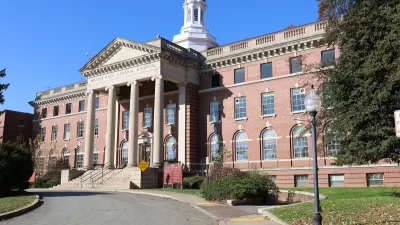A historic corner of Louisville is getting a makeover as a cultural district for the 21st century. The $28 million already has preliminary approval for $7.2 million state tourism tax credits.
Branden Klayko reports on the master plan that rejuvenated an area surrounding the historic location of the Stoneware pottery company in Louisville. Here Klayko explains the impetus for the master plan:
"But how does an early 19th-century stoneware operation stay relevant in the 21st century when the majority of its competition is made overseas at a fraction of the cost? Smith enlisted a team of architects, planners, and landscape architects led by Los Angeles– and New York–based architecture firm wHY to find out."
After focusing on the Stoneware facilities, the master plan also prioritized connections to the surrounding Paristown Pointe neighborhood. The challenges presented by the neighborhood is part of what makes this master plan stand out: "The triangular area is hemmed in by a channelized creek, elevated rail line, and steep topography. The creek historically spills its banks, inundating the low-lying area." The 50-acre neighborhood stands as a kind of secluded enclave in the city—so wHY thought it was primed for a new image.
The master plan proposes a new cultural district, "anchored by a performing arts center, a brewery-restaurant, and Smith’s stoneware company. Those three businesses define two blocks along a redesigned Brent Street, which will become a shared street that doubles as a gathering space during special events." The article includes a lot more design and planning details.
FULL STORY: Set in Stoneware

Planetizen Federal Action Tracker
A weekly monitor of how Trump’s orders and actions are impacting planners and planning in America.

Maui's Vacation Rental Debate Turns Ugly
Verbal attacks, misinformation campaigns and fistfights plague a high-stakes debate to convert thousands of vacation rentals into long-term housing.

Cuomo Is the Candidate of Both NIMBYs and Developers. What Gives?
In the New York City mayoral race, odd bedfellows align to preserve the housing status quo.

Amtrak Rolls Out New Orleans to Alabama “Mardi Gras” Train
The new service will operate morning and evening departures between Mobile and New Orleans.

The Subversive Car-Free Guide to Trump's Great American Road Trip
Car-free ways to access Chicagoland’s best tourist attractions.

San Antonio and Austin are Fusing Into one Massive Megaregion
The region spanning the two central Texas cities is growing fast, posing challenges for local infrastructure and water supplies.
Urban Design for Planners 1: Software Tools
This six-course series explores essential urban design concepts using open source software and equips planners with the tools they need to participate fully in the urban design process.
Planning for Universal Design
Learn the tools for implementing Universal Design in planning regulations.
Heyer Gruel & Associates PA
JM Goldson LLC
Custer County Colorado
City of Camden Redevelopment Agency
City of Astoria
Transportation Research & Education Center (TREC) at Portland State University
Jefferson Parish Government
Camden Redevelopment Agency
City of Claremont





























